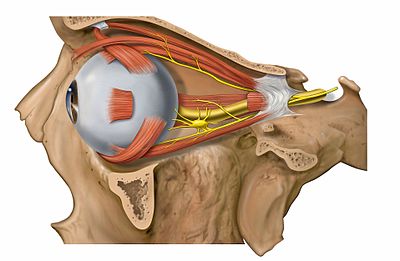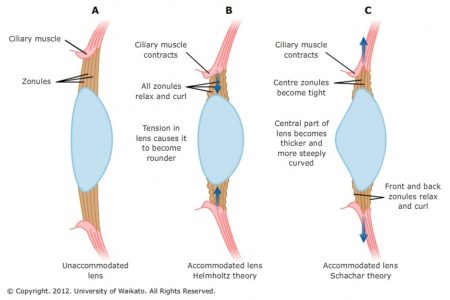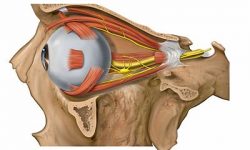A subscriber to my twice-a-month newsletter sent me this question yesterday. The extra-ocular muscles surround the eyeball (see the drawing). Extra-ocular literally means “outside the eye”. These are the muscles you’re using if you turn your eyes to look to the left, or the right, or up, or down. Dr. Bates taught that tight strained extra-ocular muscles are responsible for vision difficulties. He said that as we strain and struggle and force our eyes to see, these muscles get over-used and tired from working so hard, which leads to the eyeball being misshapen, and to poor sight. And we can’t only focus on this one facet of vision.
A classic vision exercise recommended for astigmatism, where the cornea or front of the eye becomes irregularly curved, is eye circles, to gently stretch the extra-ocular muscles. (To read more about astigmatism, see this.) If you try some slow easy eye circles, you might be surprised to find that moving your eyes in one arc of the circle feels more stiff and tense than elsewhere around the circle. This is just like an unused muscle which wakes up in the gym — you want to go slowly here, not push it! The woman who asked this question wrote that she tried eye circles, and “afterwards, my eyes felt very tired and somewhat strained”. This doesn’t mean it’s harming her, only that she needs to proceed more slowly or gently.

There are other tiny muscles which surround the lens at the front of the eye. These little ciliary muscles relax to let the lens flatten for looking in the distance, or tense to pull on the lens so it will bulge rounder for closer vision. Focusing near, then far, then near, then far, again gently and without straining, will tone these muscles and help your vision. The relationship between the ciliary muscles and the extra-ocular ones isn’t obvious, but it’s my feeling there is one. The body is one integrated intelligent system, all parts in communication with each other.
In Dr. Bates’ time, and still to a large degree today, the prevailing theory of how eyesight worked centered on the lens of the eye. Dr. Bates’ theories about the extra-ocular muscles were met with a great deal of opposition. Personally, I almost don’t care who is right, and maybe both are. I just want clear healthy relaxed vision, and for all parts of my eyes to be functioning correctly, for both near and far vision.

Here’s one possibility. Let’s say as a child I’m nervous and straining to see. I don’t really want to see because I’m so scared. Looking in the distance, my lens flattens but not enough because I’m very tense — the ciliary muscles can’t relax enough to give me clarity. So my extra-ocular muscles try to help, and squeeze my eyeball forward, temporarily giving me the typical myopic long eyeball. Then I get put in distance eyeglasses, told to wear them all the time even for close work, and my downhill slide of progressive myopia begins.
I think the best “vision practice” is not to target particular muscles too much, but to just practice seeing in different conditions. Go for a stroll and look at the mountains in the distance, or the clouds overhead. Then look at a flower at your feet. Watch a car going by — how far away does it have to be before you can’t see the details? Enjoy the bright sunshine, and walking through your neighborhood after dark, noticing what you can see in each case.
If you do some eye circles and find looking up and to the right is very sore, yes, do some gentle stretching of those muscles. And don’t forget your overall body health of good nutrition and proper hydration and sufficient rest, since this will help your vision too. Check in with your attitude also. Maybe your eyes don’t want to see that you’re stuck in a job where you hate your boss. Vision exercises won’t help that!
Your eyes, and the rest of your body, are giving you feedback all the time about how you’re functioning, and how well you’re interacting with your environment. Pay attention to what your eyes are saying they need, which is usually either more rest, or more or different stimulation. Then give that to them, to the best of your ability. When you can see well consistently, you will be well.
get help on our Facebook Group!

I wore strong glasses, then contact lenses, from age 5 into my 40s. While making many mistakes, eventually l learned how to improve the way I use my eyes and to see in a more relaxed, healthy manner. It is my pleasure to coach others to do the same. Visit me at https://NancyLNeff.com.

If your eyes are sore palm them, one of the 3 warm up routines [Sunning and splashing the eyes]. that have a cumulative effect on focusing and directional plasticity.
I heard an ophthalmologist talk about poor eyesight conditions and youthful blindness last night. Loads of contradictions… but he mentioned something i hadn’t heard. A young preschool child has “auto focus” – its dynamic and can be [re-learnt] by adults.
Eyes were designed to see moving objects, {watch what happens in a micro wave cooker swaying!} they connect / track and focus [zoom in] on minute visual detail extremely fast and actually ALL the rest is blurred out of focus – that can only happen with relaxed focusing muscles. Its these principles that vision educators present to learners. Its the connection in the moment that energizes the memory.
Thank you, Nancy. Maybe I’m trying too hard. I will go more gently on myself and really become aware of what my eyes need. I really liked that advice.
Hi, Sue. When my sister learned to improve her vision, she did eye circles so vigorously she gave herself a black eye! We try too hard in my family too. Sometimes less is more — if your eyes are getting sore, you’re doing too much. By the way, my sister now wears no glasses at all, when her eye doctor told her several years ago she would soon need bifocals.
Sometimes less is more — if your eyes are getting sore, you’re doing too much. By the way, my sister now wears no glasses at all, when her eye doctor told her several years ago she would soon need bifocals.
Hi Nancy.i have one doubt.without extraocular muscles eye will not be able to move and without movement even if iris pupil lens ciliary muscles all work fine I will only be able to look well at only one point right. So how can doctors say extraocular muscles don’t help vision
Hello Sriram and thanks for commenting. I’m not an eye doctor myself so can’t speak for them. I do know some think more “out of the box” than others, while some stick to what their training taught them. Rather than trying to convince a non-believer I’ve learned to trust my own experience, and what my own visual system tells me. Relaxation, movement, and focus on a central point are all essential for healthy vision, and both the extraocular and ciliary muscles are needed to accomplish these, to me.
I’ve learned to trust my own experience, and what my own visual system tells me. Relaxation, movement, and focus on a central point are all essential for healthy vision, and both the extraocular and ciliary muscles are needed to accomplish these, to me.
Sriram, you raise a number of issues. Dynamic vision is only present when the extra-ocular muscles are relaxed. Our combined left and right eyesight provides us with binocular vision at ALL distances 10 cm to 100 meters even skyline almost instantaneously. This provides us with perspective perception where textures and distance assessment “often moving” are scanned for single pointed attention. As our eyes [the neuro-biochemistry of the retina] is specifically designed to see micro movements. Practices or exercises that challenge these facets of vision restore dynamic vision often lost in external optical correction.
Thanks Christopher! I can always count on you for the technical anatomical explanation. Have a happy New Year!
Have a happy New Year!